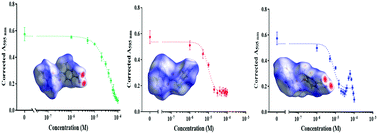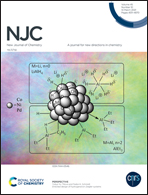Structural characterization of naphthalene sulfonamides and a sulfonate ester and their in vitro efficacy against Leishmania tarentolae promastigotes†
Abstract
Leishmaniasis, a parasitic infectious disease transmitted by sandfly bites, is an extremely complex human and veterinary disease. In humans, it takes different forms ranging from self-healing cutaneous ulcers to severe, life-threatening visceral infections. Current treatments primarily rely on chemotherapies. The current chemotherapeutic drugs, developed decades ago, are costly, toxic, and have become problematic due to drug resistance. To this end, two naphthalene sulfonamides and one naphthalene sulfonate ester were subjected to a structure–activity relationship (SAR) study for inhibition of Leishmania. The new chlorosulfonamide, N-(2′-chlorophenyl)-1-naphthalene sulfonamide (B), and sulfonate ester, 3-methyl-4-((naphthalen-1-ylsulfonyl)oxy)benzoic acid achieved (C) IC50 values of 9.5 μM and 7.4 μM, respectively, against Leishmania tarentolae promastigotes in vitro, which are notably lower than the IC50 value of 49 μM for our benchmark compound, N-(4′-carboxy-2′-methylphenyl)-1-napthalenesulfonamide (A). Additionally, all three compounds were analyzed by X-ray crystallography and show strong intermolecular interactions in the crystalline state. The new findings from this SAR study open new directions for advanced leishmaniasis treatment.



 Please wait while we load your content...
Please wait while we load your content...